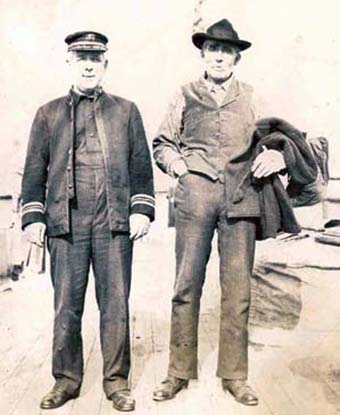Last updated: March 29, 2018
Person
Franklin G. Lowell

Photo / Resurrection Bay Historical Society
Franklin G. Lowell was born around 1848 in West Bath, Maine. His father died before he was five years old and by age 11, Frank was apprenticed to his mother’s brother, a ship builder. He grew up among ship builders and sea captains, leaving Maine with an uncle when he was about 15 years old. They sailed around Cape Horn, came through San Francisco, and arrived in Sitka between 1867 and 1868. We know that Frank arrived first in Sitka, Alaska through interviews with Frank’s daughter, Eva Lowell Revell Simons. Sitka was also the place where most ships coming up from California entered the new territory. Eva says her father first married an Aleut woman and they had a son. One year later, he moved west to the Kenai Peninsula at English Bay, present day Nanwalek, where he married Mary Forgal Lowell.
Like most sourdoughs, Frank had his hand in many enterprises: taking the census, selling salted salmon, and setting up trading posts. He outfitted Native parties who hunted fur-bearing mammals in return for their supplies and other European goods. With the drop in fur prices, the eruption of Mt. Augustine in 1883, and the economic conditions in the villages along Cook Inlet, Frank and Mary, along with several Native families, moved to the shores of Resurrection Bay. For Frank, it was a short but prosperous period living in the present day area of Seward. Eva tells us Frank had a trading post affiliated with the Alaska Commercial Company, buying fur from Native hunters and selling dried goods. She says the family had several houses in the vicinity, including a cabin beyond Lowell Point, their home on the waterfront, and several other small out-buildings as far inland as Bear Lake.
It is not clear exactly when Frank began working directly for the Alaska Commercial Company, but in 1889 he became the new agent for the Wrangell station on the outer coast of the Alaska Peninsula. As an agent for the Alaska Commercial Company and a private entrepreneur, Frank Lowell employed Alutiiq Natives to hunt sea otters and other fur-bearing mammals (black bear, fox, marten, mink, and river otter) on the outer coast of what is now Kenai Fjords National Park. The story of Frank Lowell’s outpostsand stores are integral to the park’s cultural history in Aialik Bay. His crews hunted and set up winter camps along the coast between English and Resurrection bays, including Aialik Bay and Nuka Bay.
Eva tells us her father operated a trading post from Resurrection Bay until 1892. Perhaps Frank traveled between the two sites, providing for his family as the fur trade declined after years of over hunting. Frank was the Alaska Commercial Company agent for the Wrangell fur trading station until 1898, a year when no sea otters were taken. The station could not pay expenses and the Alaska Commercial Company halted all credit to Native hunters.
Eva Lowell says her mother, Mary Forgal, refused to leave Resurrection Bay when Frank left the Alaska Commercial Company in the Cook Inlet area. From Alaska Commercial Company records, we know that Frank continued to send supplies to Resurrection Bay, paying for the supplies with fur traded to the company. Frank and Mary’s older children ran trap lines, hunted, and fished. In 1903, with her children almost grown, Mary sold her homestead rights to Frank Ballaine, who’s brother John was the future founder of Seward.
On August 26, 1895, Frank married Aralena Koshon and they eventually had four children together. Their oldest daughter, Anna, married Benny Benson’s father. Benny was the Alutiiq orphan boy who designed the Alaska state flag.
In 1910, census records identify Frank living on Chirikof Island fox farming. The same census records his daughters, Anna and Emma, living in the Herman Orphanage of Kodiak. It is assumed his wife, Aralena Koshon, died in the measles epidemic that swept through Native villages, including Port Wrangell, before the census was taken. Eva visited her father on Chirikof Island in 1912 just after the eruption of the Katmai Volcano. Shortly after her visit, Frank began blue fox farming with John Benson. Frank died at Chignik in 1923. His obituary mentions that three daughters and three sons survived him.
